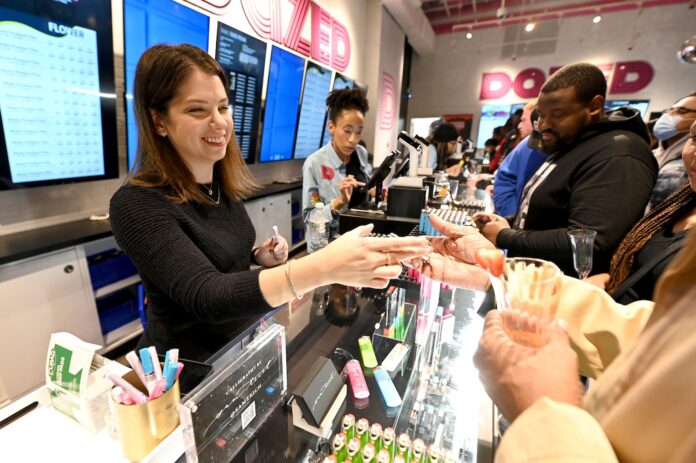WASHINGTON – Illicit cannabis sales exceeded $74 billion in 2022, outpacing the country’s legal sales of $28 billion by a staggering 164 percent according to New Frontier Data’s latest report about cannabis consumers in America. The stark gap presents clear opportunities for legal operators who can appeal to the frequent consumers who’ve become dependent on unregulated channels and the millions of adults who’ve shown an interest in cannabis but remain hesitant to try it.
To understand the underlying issues driving the industry’s multi-billion-dollar problem, New Frontier Data surveyed more than 5,500 U.S. adults across all market types. The demographically representative sample was surveyed during Q1 2023 and includes consumers who rely on a broad range of sources to procure cannabis.
U.S. cannabis consumer in a snapshot
- Approximately 42 percent of U.S. consumers source cannabis from state-regulated markets.
- Thirty-four percent live in adult-use markets.
- Eight percent are registered patients in medical-only markets.
- About 24 percent of U.S. consumers have access to state-legal cannabis but do not use licensed retailers as a primary source.
- Seventeen percent reside in adult-use markets but source cannabis elsewhere, usually from friends, family, or illicit dealers.
- Seven percent live in medical-only markets but do not participate in their state’s medical program.
- The other 34 percent of U.S. consumers do not have adequate access in their home state and would need policy reform to join the licensed cannabis market.
- Twenty-three percent live in states where cannabis is illegal.
- Eleven percent are non-medical consumers in medical states.
Converting illicit consumers to retail customers
While most dispensaries are competing against each other to serve the same group of people who’ve committed to legal markets, there are significant opportunities outside the current customer pool. According to New Frontier Data’s research, four key barriers must be overcome when attempting to attract frequent gray-market customers into licensed-dispensary shoppers.
1. Price
Those who buy from gray-market sources often also tend to consume the most the most often, with 56 percent reporting cannabis use multiple times per day. They also consume the most flower, with roughly 32 percent using more than an ounce per month. While they shop frequently and consume the most, they have lower household incomes than people sourcing from friends and family, who have lower average incomes than licensed-dispensary shoppers. By most measures, high inflation affects low-income households the most. To adequately appeal to this segment in 2024, retailers must provide products at a variety of price points with attractive promotions including bulk discounts and one-gram deals. Unfortunately, many markets deal with a level of taxation that makes competing on price alone difficult if not impossible.
2. Product variety
Manufactured, non-flower products are the legal dispensary’s differentiator. Even in adult-use states, fewer than half of surveyed consumers reported having access to anything but flower, pre-rolls, and edibles. As many as 25 percent of frequent consumers in adult-use markets who primarily purchase from friends, family, or dealers do visit dispensaries on occasion for non-flower products like vape cartridges, concentrates, and topicals. Licensed retailers could do a better job of retaining these customers with promotions like affordable flower bundled with non-flower products.
3. Product quality
According to New Frontier Data, much of the illicit cannabis sold in the U.S. is high-quality flower grown in California. To compete against the gray-market, retailers in every legal market must offer in-demand strains with a level of quality that can meet or exceed what’s being shipped from California farms. While this holds true for customers who frequently source from friends and family members, quality and freshness are especially important for frequent consumers with higher tolerances and experienced palates.
4. Accessibility
Frequent gray-market consumers disproportionately live in urban areas and may not have convenient transportation to a local licensed dispensary. Similarly, those who primarily source from friends and family disproportionately live in urban areas and may not live anywhere near a licensed dispensary. In each of these instances, achieving loyalty is next to impossible. Businesses will need to work with local regulators to change zoning ordinances and delivery coverage areas. In locations with a high population of senior citizens like Leisure World in Seal Beach, California, local dispensaries offer regular shuttle services to bring customers into the store to address this group’s primary barrier to retail shopping.
Converting the curious holdouts
While current gray-market customers may be set in their ways or dealing with barriers that are difficult to overcome, millions of other potential new adult customers are open to trying cannabis for the first time (or the first time in decades).
“Roughly two in five (39 percent) potential consumers in adult-use states described themselves as likely to try cannabis in the next six months,” the report states. “And the good news is that for any of these potential consumers who choose to begin consuming cannabis, retail is a likely and attractive source of cannabis relative to the illicit market.”
New Frontier Data’s insights about product preferences is especially important here, with 76 percent of potential customers interested in edibles. Half of the respondents said they would be interested in trying topicals, 42 percent are interested in beverages, and 28 would like to try tinctures. Only 18 percent expressed an interest in smoking flower. Although flower may dominate retail sales across the country, dispensaries properly marketing non-flower products stand the best chance of attracting a new wave of older, suburban, canna-curious individuals with disposable income.










[…] Bank Secrecy Act while accommodating the unique challenges posed by the industry. In addition, the industry continues to battle illicit market actors, casting a shadow on the legal entities working within their state laws. This only further […]
[…] Illicit Sales Outpace Legal Market by More than 3 to 1 […]